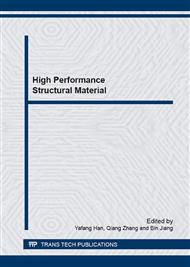[1]
Barbezat, G., Advanced thermal spray technology and coating for lightweight engine blocks for the automotive industry. Surface and Coatings Technology, 2005. 200(5-6): p.1990-(1993).
DOI: 10.1016/j.surfcoat.2005.08.017
Google Scholar
[2]
Howell, G.J. and A. Ball, Dry sliding wear of particulate-reinforced aluminium alloys against automobile friction materials. Wear, 1995. 181–183, Part 1(0): pp.379-390.
DOI: 10.1016/0043-1648(95)90045-4
Google Scholar
[3]
Vencl, A., M. Mrdak, and M. Banjac, Correlation of Microstructures and Tribological Properties of Ferrous Coatings Deposited by Atmospheric Plasma Spraying on Al-Si Cast Alloy Substrate. Metallurgical and Materials Transactions A, 2008. 40(2): pp.398-405.
DOI: 10.1007/s11661-008-9693-0
Google Scholar
[4]
Uozato, S., K. Nakata, and M. Ushio, Evaluation of ferrous powder thermal spray coatings on diesel engine cylinder bores. Surface and Coatings Technology, 2005. 200(7): pp.2580-2586.
DOI: 10.1016/j.surfcoat.2005.05.042
Google Scholar
[5]
Johansson, S., et al., Frictional evaluation of thermally sprayed coatings applied on the cylinder liner of a heavy duty diesel engine: Pilot tribometer analysis and full scale engine test. Wear, 2011. 273(1): pp.82-92.
DOI: 10.1016/j.wear.2011.06.021
Google Scholar
[6]
Kim, D., et al., Friction Characteristics of Steel Pistons for Diesel Engines. Journal of Materials Research and Technology, 2012. 1(2): pp.96-102.
Google Scholar
[7]
Kapsiz, M., M. Durat, and F. Ficici, Friction and wear studies between cylinder liner and piston ring pair using Taguchi design method. Advances in Engineering Software, 2011. 42(8): pp.595-603.
DOI: 10.1016/j.advengsoft.2011.04.008
Google Scholar
[8]
Wenzelburger, M., Modeling of thermally sprayed coatings on light metal substrates: ? layer growth and residual stress formation. Surface and Coatings Technology, 2004. 180-181: pp.429-435.
DOI: 10.1016/j.surfcoat.2003.10.125
Google Scholar
[9]
Kim, W.J., et al., Corrosion performance of plasma-sprayed cast iron coatings on aluminum alloy for automotive components. Surface and Coatings Technology, 2005. 200(1-4): pp.1162-1167.
DOI: 10.1016/j.surfcoat.2005.02.220
Google Scholar
[10]
Bobzin, K., et al., Thermal spraying of cylinder bores with the Plasma Transferred Wire Arc process. Surface and Coatings Technology, 2008. 202(18): pp.4438-4443.
DOI: 10.1016/j.surfcoat.2008.04.023
Google Scholar
[11]
Edrisy, A., T. Perry, and A.T. Alpas, Investigation of scuffing damage in aluminum engines with thermal spray coatings. Wear, 2005. 259(7-12): pp.1056-1062.
DOI: 10.1016/j.wear.2005.02.048
Google Scholar
[12]
Gérard, B., Application of thermal spraying in the automobile industry. Surface and Coatings Technology, 2006. 201(5): p.2028-(2031).
DOI: 10.1016/j.surfcoat.2006.04.050
Google Scholar
[13]
Barbezat, G. and G. Wuest, Advantages for automotive industry of plasma spray coating of Ai–Si cast alloy cylinder bores. Surface engineering, 1998. 14(2): pp.113-116.
DOI: 10.1179/sur.1998.14.2.113
Google Scholar
[14]
Pawlowski, L., The science and engineering of thermal spray coatings, 1995. Guidford, Surrey: Wiley. 414.
Google Scholar
[15]
HE, Y. -z., S. -h. SI, and X. -m. YUAN, Experimental study on the property and microstructure of the alloy overlay of plasma spray welding [J]. Materials for Mechanical Engineering, 2002. 26(12): pp.18-21.
Google Scholar
[16]
Rodrıguez, J., et al., An experimental study of the wear performance of NiCrBSi thermal spray coatings. Wear, 2003. 255(7): pp.950-955.
DOI: 10.1016/s0043-1648(03)00162-5
Google Scholar
[17]
Sajjadi, S.A., et al., Microstructure evolution of high-performance Ni-base superalloy GTD-111 with heat treatment parameters. Journal of materials processing technology, 2006. 175(1): pp.376-381.
DOI: 10.1016/j.jmatprotec.2005.04.021
Google Scholar
[18]
Truhan, J.J., J. Qu, and P.J. Blau, A rig test to measure friction and wear of heavy duty diesel engine piston rings and cylinder liners using realistic lubricants. Tribology International, 2005. 38(3): pp.211-218.
DOI: 10.1016/j.triboint.2004.08.003
Google Scholar
[19]
Parthasarathi, N.L., M. Duraiselvam, and U. Borah, Effect of plasma spraying parameter on wear resistance of NiCrBSiCFe plasma coatings on austenitic stainless steel at elevated temperatures at various loads. Materials & Design, 2012. 36: pp.141-151.
DOI: 10.1016/j.matdes.2011.10.051
Google Scholar
[20]
Bedolla-Jacuinde, A., et al., Effect of titanium on the as-cast microstructure of a 16%chromium white iron. Materials Science and Engineering: A, 2005. 398(1-2): pp.297-308.
DOI: 10.1016/j.msea.2005.03.072
Google Scholar
[21]
Ungár, T., Microstructural parameters from X-ray diffraction peak broadening. Scripta Materialia, 2004. 51(8): pp.777-781.
DOI: 10.1016/j.scriptamat.2004.05.007
Google Scholar
[22]
Sampath, S. and H. Herman, Rapid solidification and microstructure development during plasma spray deposition. Journal of Thermal Spray Technology, 1996. 5(4): pp.445-456.
DOI: 10.1007/bf02645275
Google Scholar
[23]
Kotalik, P. and K. Volenik, Cooling rates of plasma-sprayed metallic particles in liquid and gaseous nitrogen. Journal of Physics D-Applied Physics, 2001. 34(4): pp.567-573.
DOI: 10.1088/0022-3727/34/4/318
Google Scholar
[24]
Libera, M.R., et al., LIQUID SUPERCOOLINGS AND DROPLET COOLING RATES OF REMELTED ARGON-ATOMIZED FE-30NI POWDER PARTICLES. Journal of Materials Research, 1988. 3(3): pp.441-452.
DOI: 10.1557/jmr.1988.0441
Google Scholar
[25]
Sundararajan, G., D. Sen, and G. Sivakumar, The tribological behaviour of detonation sprayed coatings: the importance of coating process parameters. Wear, 2005. 258(1–4): pp.377-391.
DOI: 10.1016/j.wear.2004.03.022
Google Scholar
[26]
Ramachandran, C.S., V. Balasubràmanian, and R. Varahamoorthy, Evaluation of Dry Sliding Wear Behaviour of Plasma Transferred Arc Hardfaced Stainless Steel. Journal of Iron and Steel Research, International, 2009. 16(4): pp.49-54.
DOI: 10.1016/s1006-706x(09)60060-1
Google Scholar
[27]
Doǧan, Ö.N., et al., Wear of titanium carbide reinforced metal matrix composites. Wear, 1999. 225–229, Part 2(0): pp.758-769.
DOI: 10.1016/s0043-1648(99)00030-7
Google Scholar


